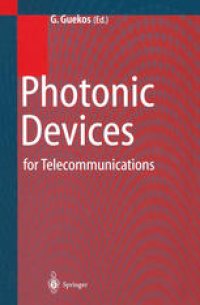
Ebook: Photonic Devices for Telecommunications: How to Model and Measure
- Tags: Microwaves RF and Optical Engineering, Optics Optoelectronics Plasmonics and Optical Devices, Communications Engineering Networks
- Year: 1999
- Publisher: Springer-Verlag Berlin Heidelberg
- Edition: 1
- Language: English
- pdf
This book focuses on the basic topics of modelling and measurement of photonic devices and discusses the most modern tools for simulation and experimentaion available to engi- neers and physicists. - Presents and compares powerful methods for numerical modelling of photonic waveguide structures and for waveguide characterisation. - Explains extensively how to model distributed feedback (DFB) lasers, the key optical source for advanced communications systems, and how to experimentally determine accurately their main characteristics. - Investigates the potential of non-linear properties of semiconductor optical amplifiers (SOAs) for fibre communications through detailed theoretical and experimental examination of the four wave mixing (FWM) effect. - Provides extensive referencing covering the latest reresearch results.
This book focuses on the basic topics of modelling and measurement of photonic devices and discusses the most modern tools for simulation and experimentaion available to engi- neers and physicists. - Presents and compares powerful methods for numerical modelling of photonic waveguide structures and for waveguide characterisation. - Explains extensively how to model distributed feedback (DFB) lasers, the key optical source for advanced communications systems, and how to experimentally determine accurately their main characteristics. - Investigates the potential of non-linear properties of semiconductor optical amplifiers (SOAs) for fibre communications through detailed theoretical and experimental examination of the four wave mixing (FWM) effect. - Provides extensive referencing covering the latest reresearch results.
This book focuses on the basic topics of modelling and measurement of photonic devices and discusses the most modern tools for simulation and experimentaion available to engi- neers and physicists. - Presents and compares powerful methods for numerical modelling of photonic waveguide structures and for waveguide characterisation. - Explains extensively how to model distributed feedback (DFB) lasers, the key optical source for advanced communications systems, and how to experimentally determine accurately their main characteristics. - Investigates the potential of non-linear properties of semiconductor optical amplifiers (SOAs) for fibre communications through detailed theoretical and experimental examination of the four wave mixing (FWM) effect. - Provides extensive referencing covering the latest reresearch results.
Content:
Front Matter....Pages i-xxxiii
Front Matter....Pages 1-5
Mode solvers and related methods....Pages 7-33
Beam propagation methods....Pages 35-65
Benchmark tests and modelling tasks....Pages 67-109
Methods for waveguide characterisation....Pages 111-138
Comparison of experimental results....Pages 139-147
Front Matter....Pages 149-152
Introductory physics....Pages 153-182
Modelling of DFB laser diodes....Pages 183-211
Measurements on DFB lasers....Pages 213-233
Parameter extraction....Pages 235-268
Front Matter....Pages 269-271
Why and how to study four-wave mixing?....Pages 273-279
Theory of four-wave mixing....Pages 281-320
Measurement techniques and results....Pages 321-338
Related topics....Pages 339-367
Back Matter....Pages 369-404
This book focuses on the basic topics of modelling and measurement of photonic devices and discusses the most modern tools for simulation and experimentaion available to engi- neers and physicists. - Presents and compares powerful methods for numerical modelling of photonic waveguide structures and for waveguide characterisation. - Explains extensively how to model distributed feedback (DFB) lasers, the key optical source for advanced communications systems, and how to experimentally determine accurately their main characteristics. - Investigates the potential of non-linear properties of semiconductor optical amplifiers (SOAs) for fibre communications through detailed theoretical and experimental examination of the four wave mixing (FWM) effect. - Provides extensive referencing covering the latest reresearch results.
Content:
Front Matter....Pages i-xxxiii
Front Matter....Pages 1-5
Mode solvers and related methods....Pages 7-33
Beam propagation methods....Pages 35-65
Benchmark tests and modelling tasks....Pages 67-109
Methods for waveguide characterisation....Pages 111-138
Comparison of experimental results....Pages 139-147
Front Matter....Pages 149-152
Introductory physics....Pages 153-182
Modelling of DFB laser diodes....Pages 183-211
Measurements on DFB lasers....Pages 213-233
Parameter extraction....Pages 235-268
Front Matter....Pages 269-271
Why and how to study four-wave mixing?....Pages 273-279
Theory of four-wave mixing....Pages 281-320
Measurement techniques and results....Pages 321-338
Related topics....Pages 339-367
Back Matter....Pages 369-404
....